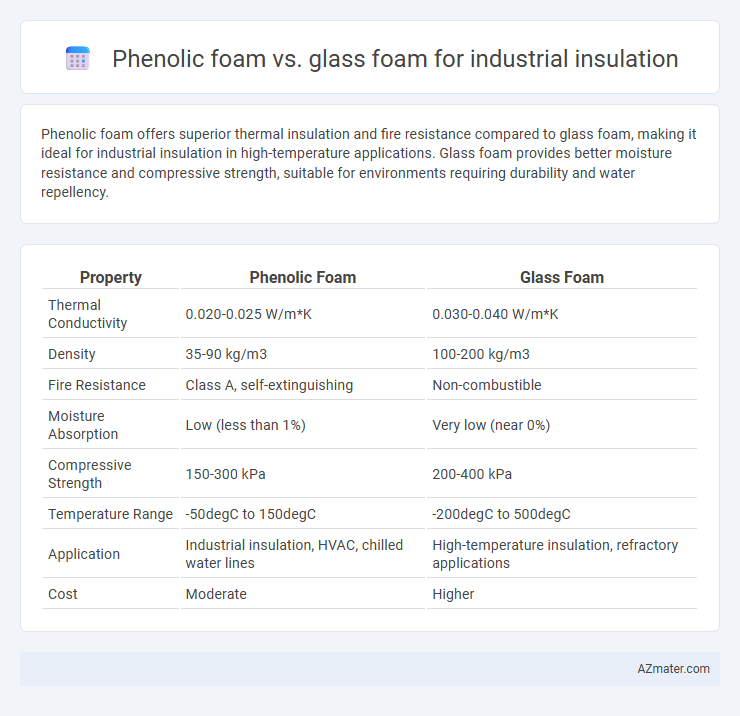Phenolic foam offers superior thermal insulation and fire resistance compared to glass foam, making it ideal for industrial insulation in high-temperature applications. Glass foam provides better moisture resistance and compressive strength, suitable for environments requiring durability and water repellency.
Table of Comparison
| Property | Phenolic Foam | Glass Foam |
|---|---|---|
| Thermal Conductivity | 0.020-0.025 W/m*K | 0.030-0.040 W/m*K |
| Density | 35-90 kg/m3 | 100-200 kg/m3 |
| Fire Resistance | Class A, self-extinguishing | Non-combustible |
| Moisture Absorption | Low (less than 1%) | Very low (near 0%) |
| Compressive Strength | 150-300 kPa | 200-400 kPa |
| Temperature Range | -50degC to 150degC | -200degC to 500degC |
| Application | Industrial insulation, HVAC, chilled water lines | High-temperature insulation, refractory applications |
| Cost | Moderate | Higher |
Overview of Phenolic Foam and Glass Foam
Phenolic foam is a high-performance insulation material known for its low thermal conductivity, excellent fire resistance, and superior moisture resistance, making it ideal for industrial applications requiring long-term durability and safety. Glass foam, made from recycled glass, offers excellent compressive strength, chemical resistance, and sound insulation properties, frequently used in industrial settings where environmental sustainability and mechanical robustness are critical. Both foams provide effective thermal insulation, but phenolic foam excels in fire safety, while glass foam stands out for eco-friendliness and mechanical durability.
Material Composition and Structure
Phenolic foam consists primarily of phenol-formaldehyde resin, forming a closed-cell structure with excellent thermal insulation and fire-resistant properties, making it ideal for high-temperature industrial applications. Glass foam, made from recycled glass melted and foamed into a rigid, porous network, offers superior compressive strength and resistance to moisture and chemical corrosion. Both materials provide effective insulation, but phenolic foam excels in fire resistance while glass foam is preferred for durability under mechanical stress in industrial settings.
Thermal Insulation Performance
Phenolic foam offers superior thermal insulation performance with a lower thermal conductivity value typically around 0.020 W/m*K, providing enhanced energy efficiency in industrial insulation applications. Glass foam, while also effective, generally exhibits a slightly higher thermal conductivity near 0.030 W/m*K and excels in high-temperature resistance and chemical stability. Selecting between phenolic and glass foam depends on balancing thermal insulation requirements with factors such as operating temperature range and environmental conditions.
Fire Resistance and Safety
Phenolic foam offers superior fire resistance with a high Limiting Oxygen Index (LOI) of around 30-35%, making it inherently self-extinguishing and low in smoke emissions. Glass foam insulation provides excellent thermal stability, is non-combustible, and melts rather than burns under high heat, ensuring effective fire safety in industrial applications. Both materials meet stringent fire safety standards, but phenolic foam's combination of low smoke toxicity and flame retardancy makes it preferable in environments prioritizing fire safety.
Moisture and Chemical Resistance
Phenolic foam offers superior moisture resistance due to its closed-cell structure, preventing water absorption and maintaining insulation performance in humid environments. Glass foam exhibits excellent chemical resistance, making it ideal for industrial settings with exposure to corrosive substances and aggressive chemicals. Both materials provide durable insulation solutions, but phenolic foam excels in moisture control while glass foam ensures longevity against chemical degradation.
Mechanical Strength and Durability
Phenolic foam exhibits superior mechanical strength and durability compared to glass foam, making it ideal for industrial insulation applications requiring robust physical performance. Its closed-cell structure results in high compressive strength and resistance to impact, while glass foam, although lightweight and thermally insulating, tends to be more brittle and less durable under mechanical stress. Phenolic foam also demonstrates enhanced long-term dimensional stability and resistance to moisture, extending its service life in harsh industrial environments.
Environmental Impact and Sustainability
Phenolic foam offers superior thermal insulation with lower global warming potential due to its reduced blowing agents and longer lifespan, contributing to decreased environmental impact compared to glass foam. Glass foam, made from recycled glass, emphasizes resource circularity and waste reduction but may consume more energy during production, affecting overall sustainability. Selecting phenolic foam benefits industries aiming to minimize carbon footprints while glass foam aligns with goals prioritizing recycled material usage and waste diversion.
Installation Process and Application Methods
Phenolic foam offers straightforward installation due to its lightweight panels that can be easily cut and fitted into complex shapes, making it ideal for pipe insulation and ductwork in industrial settings. Glass foam, typically supplied in blocks or slabs, requires mechanical fastening or adhesive bonding during installation, providing excellent compressive strength for heavy-duty applications such as flooring or high-load industrial tanks. Both materials deliver superior thermal insulation, but phenolic foam's ease of handling accelerates installation timelines while glass foam excels in situations demanding structural durability and chemical resistance.
Cost Comparison and Economic Considerations
Phenolic foam typically offers lower raw material and installation costs compared to glass foam, making it a cost-effective choice for large-scale industrial insulation projects. Glass foam, while more expensive upfront due to higher manufacturing and processing expenses, provides superior durability and thermal performance, potentially reducing long-term maintenance and energy costs. Economic considerations must balance the initial investment with operational savings, factoring in factors like insulation lifespan, thermal conductivity values, and environmental impact for optimal budget allocation.
Suitability for Industrial Insulation Applications
Phenolic foam offers superior fire resistance and low thermal conductivity, making it highly suitable for industrial insulation in high-temperature environments. Glass foam provides excellent compressive strength and chemical resistance, ideal for applications requiring durability and moisture resistance. Selecting between the two depends on specific industrial conditions such as temperature exposure, mechanical stress, and chemical environments.

Infographic: Phenolic foam vs Glass foam for Industrial insulation
 azmater.com
azmater.com